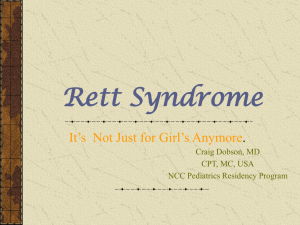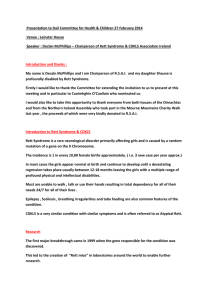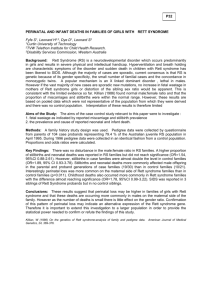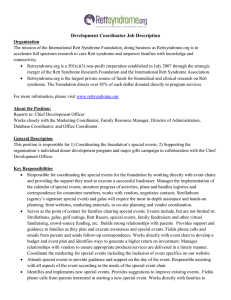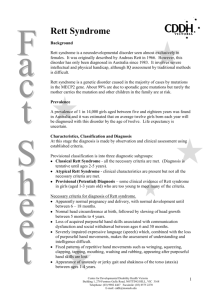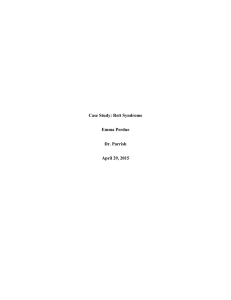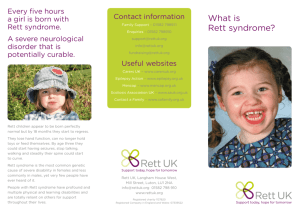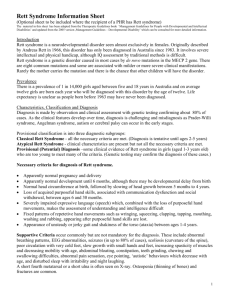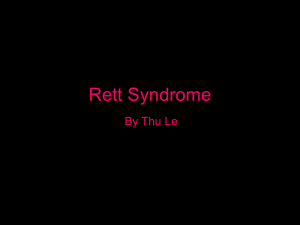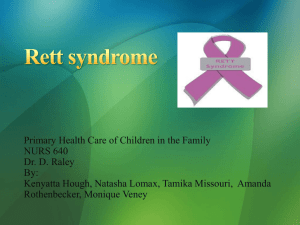Rett Syndrome ppt
advertisement
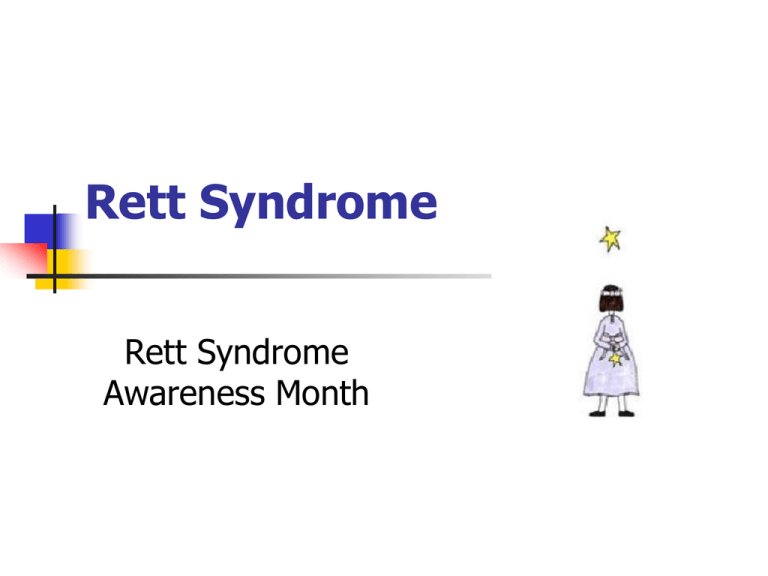
Rett Syndrome Rett Syndrome Awareness Month What is Rett syndrome? Mostly females; Normal until the age of 6 to 18 months until their development regresses Psychomotor regression-Communication dysfunction, loss of learned words, Emerging social withdrawal, Profound cognitive impairment Deterioration in developmental milestones, head circumference, overall growth What is Rett syndrome? Gait dysfunction -Poor coordination, ataxia Respiratory irregularity Early seizures Sporadic in 99.5 % cases; Hereditary factors in 0.5 % >95% of females have MECP2 mutations Stereotypic hand movements • hand-wringing • handwashing/squeezing/clapping/tapping/rubbing • hand-to-mouth • Loss of purposeful hand movements Management No cure for Rett syndrome Symptomatic — focusing on the management of symptoms Supportive, requiring a multidisciplinary approach Dietitians Physiotherapists Occupational, speech, and music therapists Hydrotherapy/Music therapy/Massage Psychosocial support GROWTH Small stature is typical Deceleration of growth Head circumference as early as 3 months • Median value at 2nd percentile by age 2 years Weight as early as 8 months Length as early as 12-14 months Hands and feet small; feet relatively smaller than hands Neurologic Abnormalities and Treatment Occurrence variable; from 20 to 80% in different reports Seizures in 75%, most severe earlier in life Abnormal EEG in 100% Truncal ataxia Dystonia may be prominent with age Treatment: Anteconvulsants, ketogenic diet for seizures Communicative and Cognitive Concerns and Treatment Babbling, single words by 10-12 months; lose verbalization by 18 months More quiet, improved eye contact with time Happy disposition Treatment: Speech/language therapy, music therapy Management of Agitation Find cause Treat cause ( reflux, constipation, infections, gall stones, seizures, headache, fractures, change of school or placement, abuse ) Use frequent snacks, music, massage, warm baths Medications Sleep Disturbances and Treatment Often disrupted; frequent awakenings Night waking, screaming, laughing Increased daytime sleep with age; delayed onset of sleep at night Consider infection (otitis media), hunger, constipation, GE reflux Treatment: Behavioral modalities, drugs Breathing Irregularities Hyperventilation, breath holding, forced air expulsion Occur while awake Modified by hunger, agitation, other stress Typically reach maximum in school years No specific therapy Gastrointestinal Issues Chewing and swallowing often poor May choke on thin liquids GE reflux typical Constipation also common; may require laxative Good nutrition essential Osteopenia Occurs in almost all girls or women Worse with poor calorie-protein intake Fractures Oral calcium , Good nutrition Orthopedic Abnormalities, Motor Disturbances, and Treatment Early truncal ataxia,Legs abducted Hypotonic early; hyperreflexive and rigid later Scoliosis (64%)-Usually apparent by age 8 years Treatment: Brace/surgery for scoliosis, orthopedic and intensive physical therapy, special computers and toys Ambulation Overall, ~ 60% remain ambulatory Orthotic devices may be needed for toe walking Great effort should be exerted to maintain ambulation Standing frames, walkers, or parallel bars should be used at home and school for those who do not walk Sexual Maturation Puberty acquired at ages similar to peers Menstrual cycles usually predictably regular after puberty well-established A variety of strategies available to manage menstrual cycles Cardiac conduction system Cardiac conduction may be immature Prolonged QT interval may be observed ECG At diagnosis (usually normal) Cardiology consult AUTONOMIC NERVOUS SYSTEM Hands and feet tend to be cold Does not appear to cause discomfort No specific treatment available Bruxism or Teeth grinding Occurs in almost all Varies in frequency and intensity May increase with anxiety or excitement Efforts to reduce generally unrewarding Tend to diminish or disappear after school age Genetic Counseling X-linked dominant inheritance If parent is a carrier, the risk to sibs of inheriting the mutant MECP2 allele at conception is 50% If a mutation is not identified in a parent, the risk to sibs is low (Germline mosaicism ) Clinical Trials Many Clinical trials esp with Dextromethorphan , Donepzil, IGF 1 Still a definitive treatment is awaited…… www.RettSearch.org Indian Rett Support Foundation Thanks
